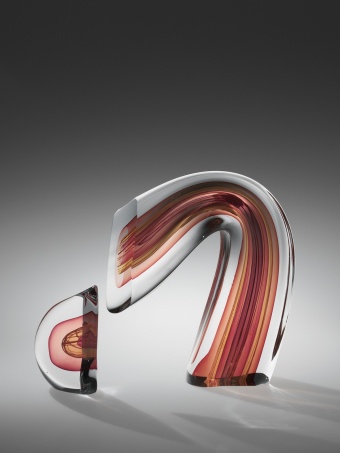Harvey K. Littleton, Bottle-Shaped Vase, 1965. Johns Manville #475 fiberglass marbles, blown. Courtesy of the Corning Museum of Glass.
With the success of the Toledo workshops, Harvey Littleton finally received approval to teach his independent study course in glassmaking at the University of Wisconsin. While it may seem like a small victory, Littleton's course was an important first step towards his larger goal of introducing glass to artists in their studios.[1] By first gaining acceptance for the medium in American art schools, making it part of university curricula, Littleton could insure that glass would gain acceptance outside of an industry setting, as a medium for art.[2] As Littleton explained of his goals for American studio glassblowing in a 1963 letter to his colleague and friend from Toledo, Dominick Labino:
I again wish to say that we appreciate the help that Johns-Manville has given us in donating the “475” glass marbles to make possible this renaissance of an almost forgotten art form...There has been an increasing public response to the revival of glassworking by the individual artist. The artist has been shut off from this material too long and design for industry without the artistic stimulus has become increasingly sterile...My aim has been to demonstrate that the modern potter, artist-craftsman, teacher, could easily learn the skills of working with hot glass, develop equipment, and develop techniques for working alone. And further, that there were unique possibilities for aesthetic expression in this material that were beyond the limits of economic industrial production.[3]During the 1963-64 academic year, thanks to an anonymous donation and the support of the University of Wisconsin, Littleton was able to rent and outfit a privately owned building near the Madison campus as a glass facility; that same year, the glass program entered the graduate curriculum and Littleton taught his last class in ceramics.[4]
Harvey K. Littleton, Eye, 1969. Blown #475 marbles, cut glass, assembled, bonded. Courtesy of the Corning Museum of Glass.
1964 was the beginning of Littleton's true recognition as a glass
artist. His first solo exhibition in New York, at the Museum of Arts and Design (formerly the Museum of Contemporary Crafts) was held in
January, and it set the stage for the presentation of works that saw
Littleton moving away from more traditional, functional forms and into
the realm of sculpture.[5] Having created works that represented
his"first obvious denial of function," Littleton noted that he "found in
glass that it lent itself to sculptural forms - or abstract forms -
very readily," fully embracing the non-functional possibilities of the
medium.[6] It was also in 1964 that the First World Congress of
Craftsmen was held in New York City, and as a trustee of the American Craft Council, Littleton played yet another decisive role for the
American Studio Glass Movement with his insistence that a hot glass
demonstration be included as part of the conference.[7] The result was
that Bill Brown, director of the Penland School of Crafts from 1962-1983, and his friend Fran Merritt, founding director of the Haystack Mountain School of Crafts,
both saw Littleton's demonstrations and became determined to introduce
glassblowing at their schools as soon as possible.[8] At the university
level, glassblowing was also soon to be introduced at Berkley, where, at
the instigation of Peter Voulkos,
Littleton was offered position as a visiting artist in glass.[9]
Although he was unable to take the position Littleton recommended it to one of his
students, Marvin Lipofsky,
who signed a contract with Berkly for 1964-1965 and
brought studio glass to the west coast.[10] The following year, glass also gained a prestigious university base in the eastern United States when Norm Schulman, who had been hired to teach clay at the Rhode Island School of Design, convinced the department to introduce glass into its curriculum.[11]
Harvey K. Littleton, Inverted Tube/Cut Line, 1977. Colorless, opaque white and red glass; blown, cut and polished with plexi base. Courtesy of the Corning Museum of Glass.
Littleton's solo exhibition in January of 1964 brought his work to the attention of Mildred Constantine, associate curator of architecture and design at the Museum of Modern Art, and in 1965, she acquired Littleton's Vase (1963) as part of the museum's collection.[12] With this recognition, in addition to his connections made through the First World Congress of Craftsmen and the growing notoriety of studio glass, Littleton's career truly took off. While still creating vessel-like forms until around 1967, by the late 1960s, Littleton completely reinvented the way that he worked with glass. According to Joan Falconer Byrd, "Virtually eliminating the reference to the vessel, he rejected complexity in favor of a strict formal vocabulary consisting of columns and tubes. Within a matter of weeks he established the fundamentals of the language of geometric forms that would underlie his mature expression in glass. From this point on, his work derived its strength from formal clarity."[13]
Harvey K. Littleton, Red/Amber Sliced Descending Form, 1984. Hot-worked and cased glass, cut, assembled. Courtesy of the Corning Museum of Glass.
[1] Corning Museum of Glass online, "Harvey K. Littleton and the American Studio Glass Movement: Harvey Littleton in Corning," http://www.cmog.org/article/harvey-k-littleton-and-american-studio-glass-movement, (accessed October 15, 2012).
[2] Ibid.
[3] Ibid.
[4] Joan Falconer Byrd, "Chapter Three: 1962-64, Birth of the Studio Glass Movement," from Harvey K. Littleton: A Life in Glass (New York, Skira Rizzoli Publications, Inc., 2011), 50-51.
[5] Ibid., 52.
[6] Ibid., 52.
[7] Ibid., 54-55.
[8] Ibid., 56.
[9] Ibid., 57.
[10] Ibid., 57.
[11] Joan Falconer Byrd, "Chapter Four: 164-68: National and International Recognition," from Harvey K. Littleton: A Life in Glass (New York, Skira Rizzoli Publications, Inc., 2011), 65.
[12] Ibid., 62.
[13] Ibid., 73.





No comments:
Post a Comment
Thanks for your comments - they mean the world to me!